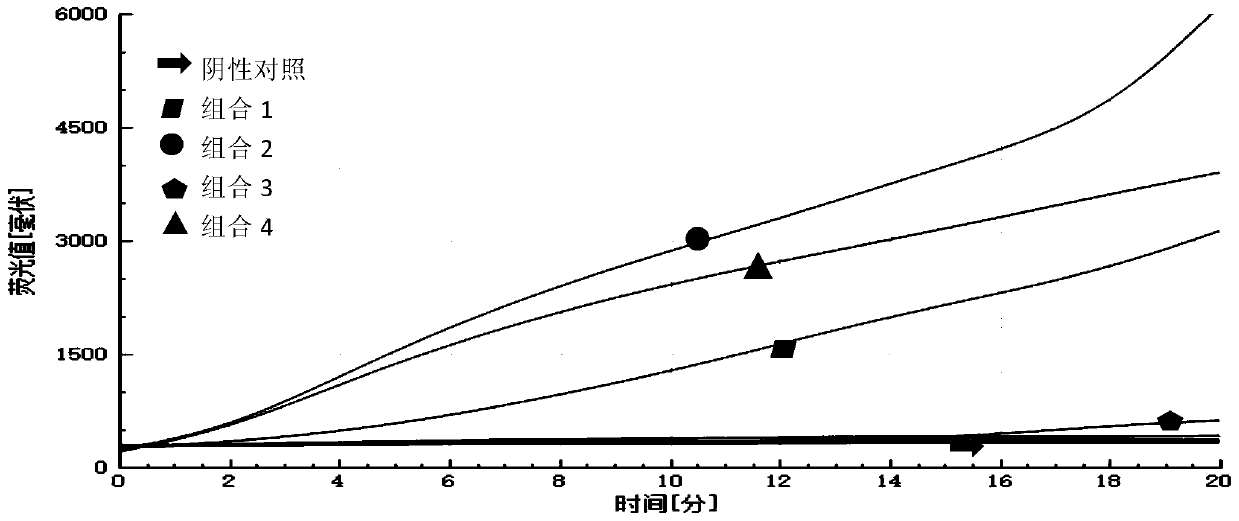RAA primer, probe and method for detecting knopvelsiekte virus
A dermatological and nodular technology, applied in the fields of biochemical equipment and methods, DNA/RNA fragments, recombinant DNA technology, etc., can solve the problems of inconvenient operation, high false positives, long detection technology time, etc., and achieve easy operation. , the effect of easy throughput and short detection time
- Summary
- Abstract
- Description
- Claims
- Application Information
AI Technical Summary
Problems solved by technology
Method used
Image
Examples
Embodiment 1
[0047] Select the conserved sequence of nodular dermatosis virus LSDV002 gene for primer and probe design Find the corresponding full gene sequence in Genebank (www.ncbi.nlm.nih.gov), use DNASTAR software for homology analysis and Blast sequence analysis , the highly conserved sequence of nodular dermatosis virus LSDV002 gene screened out is as follows:
[0048] ATATTGTCTTGGATTTTTTCATCCTTATCCAAGACAGAATCGAACGGATTTAGGTTTCCAAACATGAAGGAGATAAGCTTTTGCATTGGAAACATTAATAATGAATACAAACTATATAATTAAATTACATAATCTAGCTATAAAAAATACACAACAT (SEQ ID NO. 1);
[0049] The highly conserved sequence obtained by screening was used as the target gene fragment for detection, and positive plasmids were synthesized, and primers and probes were designed and screened for detection.
[0050] The above nodular dermatosis virus LSDV002 gene conservative sequence commissioned Sangon Bioengineering (Shanghai) Co., Ltd. to synthesize a DNA plasmid with a size of 3106bp.
[0051] (1) Primer design
[0052] Design pri...
Embodiment 2
[0078] A kind of method that RAA fluorescence method detects LSDV virus, comprises the steps:
[0079] (1) Homogenize the tissue of the sample to be tested, extract nucleic acid according to the method of tissue extraction DNA, and store it at -20°C for later use; if the sample is whole blood, serum, or plasma, use steps such as lysis, magnetic bead enrichment, washing, and elution to extract nucleic acid ;
[0080] (2) Turn on the constant temperature fluorescent gene detector RAA-F1620 for preheating, and set the reaction parameters. The reaction parameters are set to 39°C, and the reaction time is 20 minutes;
[0081] (3) Add 13.7 μL of water to 25 μL of reaction buffer, 2.1 μL of upstream and downstream primers and 0.6 μL of probe at a concentration of 10 μM, mix well, add to RAA fluorescent basic reaction reagent and mix to obtain a reaction master mix;
[0082] (4) Add 2.5 μL of Mg to the cap of the reaction tube 2+ , fully mixing 4 μL of the nucleic acid extraction so...
Embodiment 3
[0147] Embodiment 3 actual sample detection
[0148] (1) The sequences of primers, probes and negative quality controls are the same as in Example 1.
[0149] (2) A total of 15 clinical samples from 1 to 15 in the experiment were provided by the National Center for Research on Exotic Animal Diseases;
[0150] (3) Sample extraction method:
[0151] Homogenize the tissue samples first, and then extract nucleic acid according to the Tiangen commercial tissue DNA extraction method; extract nucleic acid from serum and plasma by lysing, magnetic bead enrichment, washing, elution and other steps; store at -20°C for later use;
PUM
 Login to View More
Login to View More Abstract
Description
Claims
Application Information
 Login to View More
Login to View More - R&D
- Intellectual Property
- Life Sciences
- Materials
- Tech Scout
- Unparalleled Data Quality
- Higher Quality Content
- 60% Fewer Hallucinations
Browse by: Latest US Patents, China's latest patents, Technical Efficacy Thesaurus, Application Domain, Technology Topic, Popular Technical Reports.
© 2025 PatSnap. All rights reserved.Legal|Privacy policy|Modern Slavery Act Transparency Statement|Sitemap|About US| Contact US: help@patsnap.com



